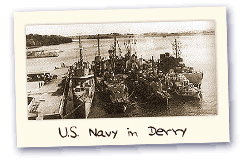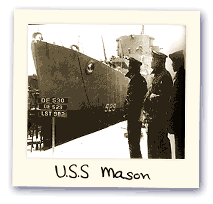The US Navy in Derry
As a young destroyer escort sailor, Martin Davis sailed on the USS Petit to Derry (The official US Navy designation for the city was Londonderry, and the sailors called it both that and Derry). His ship had made so many trips to Derry that the sailors joked that they should have dual citizenship. Now Davis is a naval historian and foremost authority on the role of the destroyer escort ships in the Second World War. Derry was the command centre for the destroyer escort. Here the anti-submarine role was plotted. In Martin Davis's opinion, Derry was a key factor in winning the war in the Atlantic.
The Nazi conquest of France left England completely isolated. Survival depended upon aid from overseas. Convoys, protected by naval escort, were the means of survival. Trawlers, yachts and other types of craft were converted for escort service, and they did not prove to be effective. Meanwhile, German submarine assaults continued and by late 1940, twenty-six  Allied ships were being sunk for every U-boat destroyed. The US Navy saw the shortage of adequate ocean escorts in the Royal Navy and recognised the same emerging need for itself. Allied ships were being sunk for every U-boat destroyed. The US Navy saw the shortage of adequate ocean escorts in the Royal Navy and recognised the same emerging need for itself.
Just prior to our entry into the Second World War, the US Congress established the Lend-Lease Act to bring American industrial strength to the aid of England. As part of the agreement, the US placed an order in early 1941 for fifty destroyer escorts, a newly designed ship that was a third of the cost of fleet destroyers, took much less time to construct and yet had the same escort and anti-submarine capabilities.
Five US Navy yards and twelve shipbuilding companies launched 565 DEs between 1942 and 1945. The average construction time was eleven months (one was actually completed in ninety-two days). Seventy eight ships were transferred to the Royal Navy, twelve went to Brazil and France and ninety-four were completed or converted to APDS (high speed transports for Pacific invasions).
Martin Davis
Martin Davis's own ship, the USS Petit, offers a story typical of the vessels that called into Derry.
The Petit sailed out of New York Harbour through Bay Ridge Channel, the Narrows and Ambrose Channel on 22 February for a rendezvous with Convoy CU-15. The convoy was destined for various areas of the British Isles.
The vessels proceeded further north than on previous convoys and before long, bitter cold and icy weather was experienced. As the ships travelled between Labrador and Scotland, off the coast of Greenland, a three-day storm raged and plagued the Petit with rough seas. All ships were taking a pounding. The heavy seas would get under the broad counter and the ship would slide down the waves at a furious pace, coming up short with a sudden jolt as she hit the bottom. The pitching and rolling continued. The life boat broke loose and sank, and several of the depth charges came loose and rolled over the side. would slide down the waves at a furious pace, coming up short with a sudden jolt as she hit the bottom. The pitching and rolling continued. The life boat broke loose and sank, and several of the depth charges came loose and rolled over the side.
Spray was lashing at the flying bridge as waves broke over the bow, saturating those on watch. In spite of this, the Petit maintained effective control speed. No food could be cooked, so it was sandwiches and canned food. Personnel strapped themselves into their bunks, but there was little sleep. During the storm, the safe broke loose in the captain's cabin and went crashing into the bulkhead. Finally, the sea calmed and the mess deck went back into operation and was serving cooked food again.
Three days out of port, General Quarters was sounded and all hands rushed to their battle stations. A ship near the centre of the convoy was afire, silhouetting the entire convoy against the evening skyline. High octane aviation fuel flames leaped into the air and it wasn't long before another ship was observed in flames. The DEs went into the area to investigate and pick up any possible survivors. It was later learned that the SS Goston and the SS Murpheysboro had collided. Only one crew member was killed in the accident and the USS Ricketts picked up survivors of the vessels.
On 5 March, Bloody Foreland Hill on the north-west coast of Ireland was sighted and two hours later, Tory Island Light came into view. The escorts were relieved of their charges and proceeded to anchor in Lough Foyle, off Moville in the Irish Sea. From the anchorage, one could see Dungaree Point Light abeam to starboard and Magilligan Point Light blinked a welcome to port.
Ship history - USS Petit
> > > Read the concluding part of this article.
From Home Away from Home.The story of the American Army in Ireland during WWII. Find out how you can order this book.
|
|



 Allied ships were being sunk for every U-boat destroyed. The US Navy saw the shortage of adequate ocean escorts in the Royal Navy and recognised the same emerging need for itself.
Allied ships were being sunk for every U-boat destroyed. The US Navy saw the shortage of adequate ocean escorts in the Royal Navy and recognised the same emerging need for itself.
 would slide down the waves at a furious pace, coming up short with a sudden jolt as she hit the bottom. The pitching and rolling continued. The life boat broke loose and sank, and several of the depth charges came loose and rolled over the side.
would slide down the waves at a furious pace, coming up short with a sudden jolt as she hit the bottom. The pitching and rolling continued. The life boat broke loose and sank, and several of the depth charges came loose and rolled over the side.